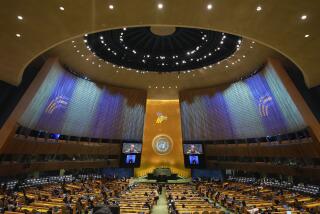Back to the Future: Recent Trade Accords Almost Happened in 1950
- Share via
Anyone following the GATT negotiations late last year had to relish the last-minute suspense--particularly in the Franco-American battle for the hearts and minds of European movie fans.
Much of the hubbub would have been unnecessary, had we acted decisively nearly 50 years ago.
In the summer of 1941, President Franklin D. Roosevelt and British Prime Minister Winston Churchill met aboard a U.S. destroyer in the North Atlantic to discuss the conduct of the world war.
The leaders’ final communique--the Atlantic Charter--conveyed their belief that, whatever the war’s outcome, any future world order must prevent recurrences of the currency devaluations and beggar-thy-neighbor trade policies that had so deepened the world Depression and led in no small part to the cataclysm they were then seeking to overcome.
“(We) will endeavor,” it said, “to further the enjoyment by all states, great or small, victor or vanquished, of access on equal terms to the trade and to the raw materials of the world.”
Soon after the war’s end, institutions were created to give the world a new economic order: the United Nations with its International Monetary Fund and World Bank, and the Marshall Plan, among others.
American diplomats next set out to complete the missing link by negotiating an international agreement that would liberalize world trade. In 1948, some 54 nations signed the Havana Charter, which was to govern a new International Trade Organization (ITO).
The charter established three key principles that are still with us today: non-discriminatory treatment of all parties, a commitment to reducing tariffs and other trade barriers and elimination of all import quotas, except under emergency conditions.
But the charter’s significance was deeper: It addressed many of the thorniest issues that would haunt trade talks for the next 45 years.
Among other things, it forbade discriminatory taxation and regulated state monopolies. It limited the use of domestic-content requirements and other non-tariff barriers and administrative procedures employed by states to circumvent their commitments to open borders. It also prohibited restrictive business practices and cartels that could serve as private controls over competition. It regulated the use of public subsidies and countermeasures, such as anti-dumping procedures.
Finally, the charter called for rules against double taxation, protected the owners of patents and other “intangible” assets, promoted the elimination of unfair labor practices and provided foreign investors guarantees of fair and reasonable treatment.
The charter’s provisions applied equally to goods and services. Article 19, for example, allowed member countries to maintain “screen quotas” for domestic movies, but specified that the quotas were “subject to negotiation”--obligating the countries to reduce them over time. As Clair Wilcox, head of the U.S. delegation, put it: “Other nations are using 17 kinds of discrimination against American films. We got them down to one, and it is negotiable!”
Under that provision, quotas limiting European viewers’ access to U.S.-made films and television programming might have been reduced to insignificance long ago.
Yet, late in December, 1950, the Truman Administration--preoccupied with the Korean conflict--let it be known that the Havana Charter would not be submitted to Congress.
*
Why did it fail?
Many business organizations were opposed to greater government intervention in markets. Liberals thought the treaty was too weak; conservatives saw it as a threat to national sovereignty. Republican gains in the 1950 congressional elections strengthened those who favored greater reliance on tariffs and protection of U.S. industry. And Southern Democrats, traditionally supporters of free trade, were changing their views as manufacturing expanded in the South.
For the next 43 years, each of the seven successive negotiating rounds of the GATT--initially established as a stopgap forum for discussing tariff reductions only--has had to tackle the issues left on the table at Havana.
What can we conclude from this experience?
First, the specter of lost national sovereignty, which played such a critical role in defeating the ITO, is less relevant today. NAFTA, bilateral discussions with Japan and the growth of regional markets have made it legitimate for governments to seek concessions regarding each others’ tax and fiscal policies, labor and wage practices and environmental concerns.
Second, as regional blocs have gained scope and importance, they have served as testing grounds for new rules about complex issues--for example, the rules on reciprocity in financial services within NAFTA. These can then be extended on a multilateral basis.
Third, appropriate dispute-resolution procedures are critical. In a rule-based system, interpretation and enforcement must go hand in hand with rule-making. The GATT’s caseload increased enormously in the 1980s, to 120 cases, versus 90 in its first 32 years. Yet its adjudication powers remain so primitive that many cases were not resolved--or, worse, its findings were ignored.
So, while there is much to complain about regarding what did not get done in Geneva in December, there is much for which to be thankful. We are slowly reconstructing the edifice we tore down in 1950.
Who knows? Maybe the old wording of Article 19 can be revived. Bring on the script doctors!
More to Read
Sign up for Essential California
The most important California stories and recommendations in your inbox every morning.
You may occasionally receive promotional content from the Los Angeles Times.










